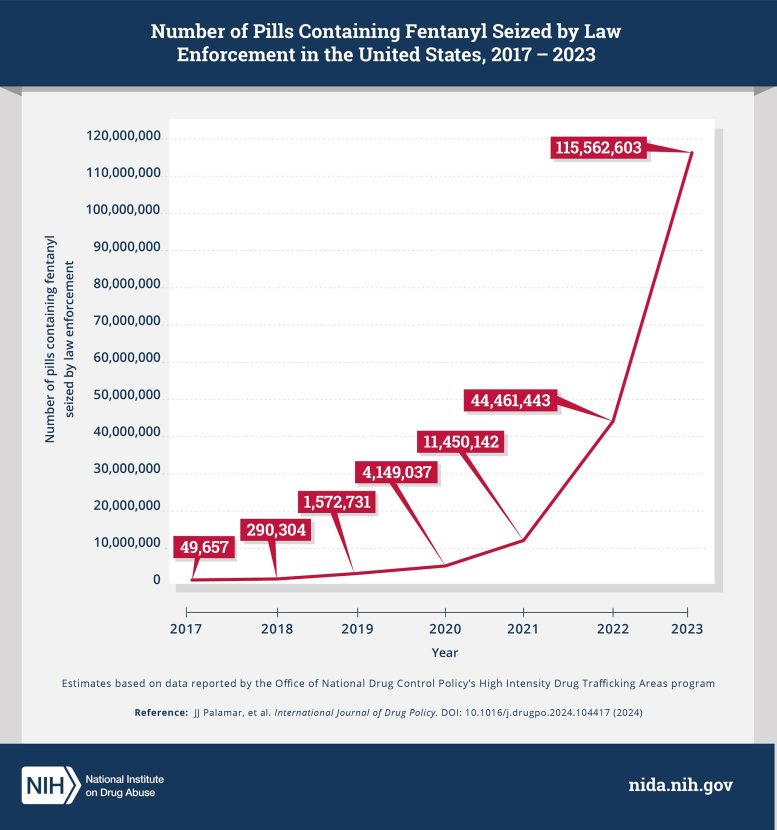
From 2017 to 2023, U.S. law enforcement reported a significant increase in seizures of illicit fentanyl, particularly in pill form. Over 115 million fentanyl-containing pills were seized in 2023, up from about 50,000 in 2017. Credit: SciTechDaily.com
NIH-supported study highlights increasingly dangerous illicit drug supply, risk of pills not coming from a pharmacy.
Law enforcement seizures of illicit fentanyl increased dramatically in number and size between 2017 to 2023 in the U.S., especially in pill form, according to a new study funded by the National Institutes of Health’s (NIH) National Institute on Drug Abuse (NIDA).
The number of individual pills containing fentanyl seized by law enforcement was 2,300 times greater in 2023 compared to 2017, with 115,562,603 pills seized in 2023 vs. 49,657 in 2017. The proportion of fentanyl pill seizures to the total number of fentanyl seizures more than quadrupled, with pills representing 49% of illicit fentanyl seizures in 2023 compared to 10% in 2017. The study also found a significant increase in the number and weight of fentanyl-containing powder seizures during this time.
National Institute on Drug Abuse Director’s Warning
“Fentanyl has continued to infiltrate the drug supply in communities across the United States and it is a very dangerous time to use drugs, even just occasionally,” said NIDA Director Nora D. Volkow, M.D. “Illicit pills are made to look identical to real prescription pills, but can actually contain fentanyl. It is urgently important that people know that any pills given to someone by a friend, purchased on social media, or received from any source other than a pharmacy could be potentially deadly – even after a single ingestion.”

Graph showing the number of pills containing fentanyl seized by law enforcement over time. Estimates based on data reported by the Office of National Drug Control Policy’s High Intensity Drug Trafficking Areas program. Credit: NIH/National Institute on Drug Abuse
Although fentanyl seizures were historically less common in the Western U.S., this analysis found that this region now accounts for most of law enforcement seizures of fentanyl overall, as well as total weight of fentanyl seized. The proportion of fentanyl pill seizures compared to the overall number of fentanyl seizures was also highest in the West, with 77.8% of all law enforcement seizures of fentanyl in the West being in pill form in 2023. These data emphasize the need for continued monitoring of regional shifts in the fentanyl supply, to help inform targeted prevention and public health responses.
Opioid Crisis Statistics
In 2022, over 107,000 people died of a drug overdose, with 75% of those deaths involving an opioid. The overall rise in overdose deaths is largely attributable to the proliferation of illicit fentanyl, a synthetic opioid. Illicit fentanyl is highly potent, cheaply made, and easily transported, making it extremely profitable. Fentanyl is about 50 times more potent than heroin and a lethal dose may be as small as two milligrams.
While some people knowingly consume fentanyl, many people do not know if the drugs they plan to use contain fentanyl. This is especially true of illicit counterfeit pills, which are often made to resemble prescription medications such as oxycodone or benzodiazepines, but really contain fentanyl. Recent studies have reported a dramatic rise in overdose deaths among teens between 2010 to 2021, which remained elevated well into 2022 according to a NIDA analysis of CDC and Census data. This increase in deaths has been largely attributed to widespread availability of illicit fentanyl, the proliferation of counterfeit pills containing fentanyl, and the ease of purchasing pills through social media.
“Availability of illicit fentanyl is continuing to skyrocket in the U.S., and the influx of fentanyl-containing pills is particularly alarming,” said Joseph J. Palamar, Ph.D., M.P.H., associate professor in the Department of Population Health at NYU Grossman School of Medicine, New York City, and lead author on the paper. “Public health efforts are needed to help prevent these pills from falling into the hands of young people, and to help prevent overdose among people taking pills that unsuspectingly contain fentanyl.”
Real-Time Data and Public Health Response
The data used for this analysis were collected through the High Intensity Drug Trafficking Areas (HIDTA) program, a grant program aimed at reducing drug trafficking and misuse administered by the Office of National Drug Control Policy. Though law enforcement seizures do not necessarily reflect the prevalence of use, they represent an indicator of the availability of illicit drugs.
Unlike most survey data and surveillance systems which can be lagged for a year or more, HIDTA data are made available quarterly, allowing evaluation in almost real time. HIDTA data also distinguish between the presence of fentanyl in pill or powder form. Analyzing these data can therefore help identify trends in availability of illicit substances and act as a type of early warning system to shift public health education or interventional resources more quickly.
HIDTA data does not differentiate between fentanyl and its analogs, nor estimate the amount of fentanyl present in seized substances. However, given the small amount necessary for an overdose, the authors note that the presence of any fentanyl is an important indicator of overdose risk.
This analysis, published in the International Journal of Drug Policy, was led by researchers from the NIDA-funded National Drug Early Warning System (NDEWS). It builds on a previous NDEWS study of trends in seizures of powders and pills containing illicit fentanyl in the U.S. between 2018 and 2021.
For more on this research, see Fentanyl Pill Seizures Skyrocketed by Over 1,700% Since 2017.
Reference: “National and regional trends in fentanyl seizures in the United States, 2017–2023” by Joseph J. Palamar, Nicole Fitzgerald, Thomas H. Carr, Linda B. Cottler and Daniel Ciccarone, 13 May 2024, International Journal of Drug Policy.
DOI: 10.1016/j.drugpo.2024.104417
If you or someone you know is struggling or in crisis, help is available. Call or text 988 or chat at 988lifeline.org. To learn how to get support for mental health, drug or alcohol issues, visit FindSupport.gov. If you are ready to locate a treatment facility or provider, you can go directly to FindTreatment.gov or call 800-662-HELP (4357).









Looking at the chart in the article it becomes clear that the increase in fentanyl seizures (and presumably a corresponding increase in smuggling) really took off in early 2021. Gee whiz, I wonder why…